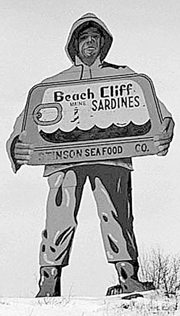|
Over time, particularly in the last twenty years, advances in technology and marketing have caused major changes in Maine's herring industry. The shift from weir fishing to purse seining, and then from purse seining to mid-water trawling, have taken the fishery away from the coastal communities that once depended on it, and concentrated it in the fish holds of an estimated 20 boats that land roughly 90 percent of the catch.
At the same time, increasing globalization of the herring market, the dissolution of the Maine Sardine Council, and the impending sale of Stinson's Seafood, the state's largest single herring buyer (see sidebar), raise the question of what Maine's herring industry will look like in the future.
The latest herring management plans, devised by the New England Fishery Management Council (NEFMC) and the Atlantic States Marine Fisheries Commission (ASMFC) try to balance the interests of stakeholders from New Jersey to Eastport, and beyond, while still addressing local issues.
Both plans establish a total
|
 |
spawning closures it felt were not cost effective, in-season adjustments of the TAC in area 1A, and the prohibition of foreign fishing.
At the January 13th meeting of the Joint Herring Oversight Committee, NEFMC member Eric Smith, pointed out that many of the NMFS reasons for disapproving parts of the Council's plan failed to recognize
"These mid-water boats
are massacring the herring that downeast Maine depends on."
why the measures were called for to begin with. "The spawning closure was in part a habitat disruption issue," said Smith, but he noted that the NMFS disapproval letter failed to address that.
Noting that NMFS appears to be undermining the Council's conservation efforts Smith asked, "When do we send back a 'cruise missile of a letter' to the Service that tells them we don't think this is appropriate behavior on their part?"
continue
|
|
allowable catch (TAC) for each
of four management areas as the primary control of fishing mortality. In addition, they set limits on the size of vessels that can take herring, and call for spawning closures. Although the individual states accepted the ASMFC plan, the National Marine Fisheries Service (NMFS) only partially accepted the Council plan.
NMFS disagreed with taking days out of the fishing season to avoid exceeding the TAC,
|
|

